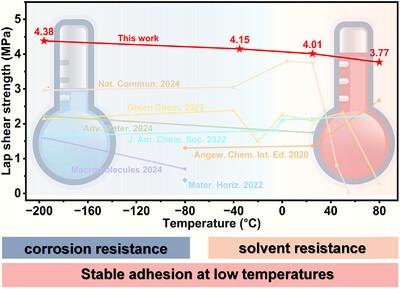具有高粘接强度和多环境适应性的超低温动态交联仿生胶粘剂
IF 19
1区 材料科学
Q1 CHEMISTRY, MULTIDISCIPLINARY
引用次数: 0
摘要
木基复合材料在极地房屋建设和海上石油工程等复杂环境中表现出巨大的应用潜力。优良的木材胶粘剂对木制品的耐候性、结构韧性和环保性能至关重要。然而,传统的胶粘剂存在耐水性差、有毒残留和依赖高温压固化的问题。受燕窝蛋白交联的启发,本研究通过原位环氧化修饰羧基丁苯乳胶,将非极性双键转化为高活性基团。通过将多氨基预聚物、改性二氧化硅和环氧改性乳液相结合,构建了一种双物理-化学交联体系,从而开发了冷压胶粘剂。该材料表现出优异的干/湿抗剪强度(4.03/1.96 MPa)和脱粘功(2.47 J),在极端温度范围(- 196至85°C)下的强度损失小于7%,并显著改善了低温脆性(- 196°C时3.67 MPa的强度保持)。此外,它还具有持久的耐溶剂性(浸泡36天后保持70%的强度)和阻燃性能。基于这些优异的性能,设计用于无热粘合的木材胶粘剂有望用于各种复杂环境,包括极地房屋建设,深海石油开采和空间应用。本文章由计算机程序翻译,如有差异,请以英文原文为准。

Dynamically Crosslinking Bio-Inspired Adhesives with High Bond Strength and Multi-Environmental Adaptability for Ultra-Low Temperature Adhesion
Wood-based composite materials exhibit significant potential for applications in complex environments such as polar house construction and offshore oil engineering. Excellent wood adhesives are crucial for the weather resistance, structural toughness, and environmental performance of wooden products. However, traditional adhesives suffer from poor water resistance, toxic residue, and reliance on high-temperature press curing. Inspired by the crosslinking of bird nest proteins, this study modifies carboxylated styrene-butadiene latex through in situ epoxidation, converting non-polar double bonds into highly reactive groups. By combining multi-amino prepolymers, modified silica, and epoxy-modified emulsion, a dual physical-chemical crosslinking system is constructed, resulting in the development of a cold-press adhesive. The material demonstrates excellent dry/wet shear strength (4.03/1.96 MPa) and debonding work (2.47 J), with a minimal strength loss of less than 7% across extreme temperature ranges (−196 to 85 °C) and significantly improved low-temperature brittleness (−196 °C strength retention at 3.67 MPa). Additionally, it exhibits long-lasting solvent resistance (70% strength retention after 36 days of immersion) as well as flame-retardant properties. Based on these excellent properties, wood adhesives designed for heat-free bonding are expected to be used in a variety of complex environments, including polar house construction, deep-sea oil extraction, and space applications.
求助全文
通过发布文献求助,成功后即可免费获取论文全文。
去求助
来源期刊

Advanced Functional Materials
工程技术-材料科学:综合
CiteScore
29.50
自引率
4.20%
发文量
2086
审稿时长
2.1 months
期刊介绍:
Firmly established as a top-tier materials science journal, Advanced Functional Materials reports breakthrough research in all aspects of materials science, including nanotechnology, chemistry, physics, and biology every week.
Advanced Functional Materials is known for its rapid and fair peer review, quality content, and high impact, making it the first choice of the international materials science community.
 求助内容:
求助内容: 应助结果提醒方式:
应助结果提醒方式:


